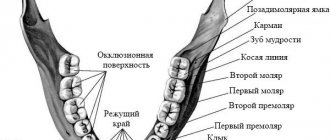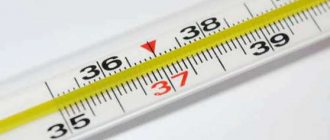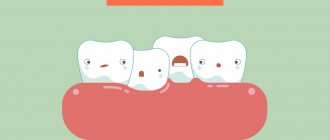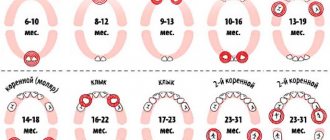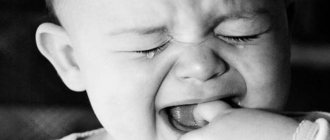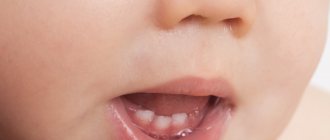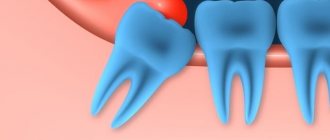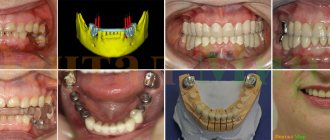When and how do the upper teeth cut?
Teeth, including the upper ones, are not cut all at once. They have certain deadlines. But they begin to torment long before they pass through the bone and pierce the soft tissue of the gums. This is how the human body works. But there is no point in blaming nature or the higher mind that invented it all. You need to think about what to do to alleviate the condition in the process.
- From approximately the sixth to the ninth month, the lower (first) incisors erupt. The process is accompanied by a lot of unpleasant sensations.
- From the seventh to the tenth month of life, the upper (first) incisors appear in the baby's mouth. The consequences are the same.
- From the ninth month to one year, the upper and lower second incisors appear in the mouth.
- Lastly, at the age of one and a half to two years, the upper and lower canines are cut.
Teething pattern
Polyodontia (supernumerary teeth) - symptoms and treatment
For a successful prognosis in treatment, high-quality and timely diagnosis of patients is very important. The dentist-therapist must know the basic clinical manifestations and principles of diagnosing hyperdentia. This is especially important in the work of a pediatric specialist during periods of medical examination and planned sanitation of the oral cavity in children. This makes it possible to identify the presence of this anomaly at an early age and carry out appropriate treatment in the early stages.
Most often, “extra” teeth are located in the anterior part of the upper jaw. The question of the exact location of supernumerary teeth is very important, since the surgical stage of treatment depends on this. The more accurately the position of various anatomical formations is determined, the less surgical trauma (damage to the growth zones of complete teeth, the formation of large defects in the bone of the alveolar process) will result from the surgical stage of treatment. The volume and time of the procedure will be reduced, which is very important when it comes to treating children. The position of the causative tooth can be determined using instrumental examination methods:
- CT scan;
- orthopantomography;
- intraoral radiography;
- visiography;
- Magnetic resonance imaging.
Computed tomography allows you to obtain a cross-sectional, layer-by-layer image of any area of the human body, including the skull. Dental (dental) X-ray computed tomography allows you to make 4 types of images in different planes in one and a half minutes. The radiation dose with this examination method is less than other types of CT. The procedure is easily tolerated by patients and does not require special training, which is convenient when working with children. In addition, it is as informative as possible for the doctor.
Orthopantomography is a method of x-ray examination in which you can obtain an image of all the patient’s teeth, upper and lower jaws, adjacent tissues and areas of the facial skeleton. Conducted for children from 3-4 years old. This is a quick, simple, highly effective method that helps identify oral diseases in the early stages. It has virtually no clinical contraindications and is actively used by dentists.
Intraoral radiography is the simplest, most common diagnostic method in therapeutic dentistry. The picture shows from one to 3-4 teeth and adjacent formations. For the pathology under consideration, the method is not informative enough, but can be used if the above types of diagnostics are unavailable.
Visiography is a system for obtaining X-ray images without the use of film. In this type of research, instead of film, a special sensor is used, from which the image is transferred to a computer, after which it is processed and then saved. Advantages of this technique:
- The radiation exposure to the patient is tens of times lower compared to the most advanced film X-ray, which is extremely important for both the patient and the radiologist.
- Scalability and the possibility of mathematical image processing (measuring the size, density of objects, etc.).
- It is possible to store the received information and create your own database for each patient.
- There is the possibility of instant transfer of diagnostic data directly from the treatment room to the computer monitor of the attending doctor, wherever he is. This is very convenient if you need to consult doctors from different clinics or from different cities.
But, as with intraoral radiography, the image produces a low-informative planar image of the area under study, limited to 1-4 teeth.
Magnetic resonance imaging is a radiation diagnostic method that can be used to obtain an image of the layers of the human body in any plane. The method is simple and does not have any harmful effects on the body of the subject. A contraindication for MRI is the presence of metal foreign bodies (dentures, braces, surgical pins, etc.) in the patient’s body.
Sometimes, to determine the level of location of problem teeth, Yu.I.’s technique Zhigurta (1994). It consists of studying an orthopantomogram of the jaws and marking on it the four levels of occurrence of unerupted incisors and canines. However, this method is imperfect and does not allow an accurate assessment of where the supernumerary tooth is located. It is more advisable to use modern diagnostic methods described above.
To more accurately determine the relationship of the additional tooth with the roots and rudiments of the complete teeth, contact intraoral radiographs are taken in the preoperative period and 1, 3, 6 and 12 months after the operation. They are used to determine the degree of change in the position of the impacted tooth, the condition of the root of the complete tooth and the morphological structure of the bone of the alveolar process in the studied area [1][7][8].
What accompanies the eruption of baby teeth?
A list of “suffering, pain and sleepless nights for parents” would be suitable here, as well as constant trips to doctors, buying a bunch of necessary and unnecessary medications... But I want to write about what you really need to know.
Teething is a painful process
The fact that the child will be hurt is clear even without me. When a piece of bone protrudes through the gums, it is difficult not to notice this process. The gums immediately begin to become inflamed, and bacteria multiply in the mouth. If we talk about other symptoms of teething in the upper teeth, it is worth remembering that this condition is often accompanied by a significant increase in temperature. The child may lose appetite. Still, how can you eat normally when your mouth hurts?
Children immediately begin to put their hands and various objects into their mouths, which always ends with another classic childhood problem - stomatitis.
Baby teether
In general, stomatitis and gingivitis (inflamed gums) are classics of the genre during this period. Dysbacteriosis following this process can lead to intestinal problems. Hence - diarrhea and vomiting.
If inflammation of the gums during teething of the upper teeth can be eliminated by rinsing with decoctions of chamomile, sage and other natural remedies, then they relieve pain only slightly.
- If a white coating appears in your mouth, it means that a fungus has developed that causes candidal stomatitis.
White coating on the tongue - Temperatures from 37 to 38.5 degrees are common.
If it rises to 39 or more, call an ambulance. It is quite possible that some kind of inflammatory process has occurred. And such temperatures are poorly tolerated at such a young age. The child has a fever - Diarrhea is not a symptom of teething, but a sign that there are fewer “good” bacteria than harmful ones. And not only in the mouth, but also in the digestive system. This needs to be fixed.
Relieving teething symptoms
When does a child's molars come out?
The eruption of a child’s molars is one of the most important periods in the development of a child’s body. It is quite painful, so parents need to be prepared for it and know when their baby’s molars begin to cut.
The first milky shoots are usually formed within 2 years, there are 20 of them in total. As already mentioned, among them there are two pairs of molars. The exact time when the first molar teeth begin to erupt has not been established. This depends on many factors: diet, heredity, climatic conditions of the region of residence, and the quality of drinking water.
If we talk about the first molars, they appear in the baby at the age of 12-17 months. Even if this process is delayed in your case, there is no need to worry. By the 32nd month they will definitely thin out. Second molars begin to erupt at 24-33 months, and the process is completed by 38-48 months. It must be taken into account that the growth and development of each child is individual. This also applies to teething. Even if the timing of the eruption of your child’s first molars is delayed or, conversely, they appear earlier in him than in his peers.
The growth of baby teeth usually stops by the age of three. By the age of five or six, the first signs of their change to radical ones begin to appear (in some children later). The entire process of formation of permanent teeth ends by the age of 12-14 years.
Medicines that can be given to a child
When children develop a fever, they are usually given paracetamol. Only now there is a whole stack of scientific articles with authoritative sources that talk about how dangerous this drug is for babies. It is associated with asthma symptoms, breathing problems and many other complications. To risk? Of course, I am not a doctor, but I would not conduct such experiments on my child.
Paracetamol
The second thing that mothers and fathers usually think about, as well as pediatricians, is how to relieve pain. The process of teething the upper teeth in infants is too painful.
In 9 cases out of 10, medications prescribed to children may contain lidocaine.
There are also a lot of articles on why you shouldn’t use them, including a report by the American Food and Drug Review Organization. If we simplify everything to the point of banality, then this is what comes out. No gel can quickly absorb and stay on wet gums. As a result, part of the substance ends up under the tongue, and part is swallowed. The baby begins to drool because his tongue is numb, and if he swallows the anesthetic, he may face an even greater danger - the substance getting into the throat and respiratory tract.
Baby is drooling
As soon as the swallowing reflex is blocked or breathing problems arise... I won’t continue further, because it’s scary to even think about it. Therefore, let’s ask what is the safest to use.
Cholisal is often recommended. It is less harmful, but the instructions clearly state that children under one year of age should be used with caution. Mundizal has the same composition, only it is produced by a different company.
"Cholisal gel"
The popular Dentinox gel also contains lidocaine.
Dentokind
If you want something less harmful, there is, for example, Dentokind. It is homeopathic with chamomile and belladonna. Relieves inflammation and generally has a “calming” effect. For teething upper teeth in children under one year old, this is an excellent option. If you combine this remedy with regular rinsing of your mouth with solutions of soda, chlorhexidine and iodinol, you can achieve significant relief, and at the same time get rid of accompanying stomatitis. Overall, the recipe is simple and affordable.
However, no matter how confident you are in yourself, your knowledge and the help of the omniscient Google, do not neglect the help of an experienced pediatrician and pediatric dentist.
Teeth cutting: how to help your child
There are a lot of products that only doctors and pharmacists know about, but you and I have never even heard of. It's worth trying your luck. Suddenly they will prescribe you something that is not very expensive and at the same time quite effective.
So, if your child’s temperature starts to rise, loss of appetite, problems with normal sleep and digestion, don’t play know-it-all, but call the doctor or take your baby to the clinic. This makes it much more likely that you will resolve the issue faster and safer for your health.
Features of the period.
During this period, the formation and further development of the roots of baby teeth occurs: they are strengthened in the bone tissue of the jaws. The processes of root formation smoothly flow into the processes of their resorption and replacement with permanent teeth, the rudiments of which are located under the milk teeth.
The presence of interdental spaces between the incisors and canines of the upper and lower jaws is a sign of a “normal” correctly developing occlusion of primary teeth. The absence of interdental spaces in the primary dentition indirectly indicates a lack of space for the eruption of permanent incisors and canines, the crowns of which are significantly wider.
PHOTO: Teeth of a 3-year-old child. By the age of 3, a child already has a full set of teeth in his mouth. There should be spaces between baby teeth.
Starting from 5-6 years of age, the bite of temporary (baby) teeth is replaced with permanent ones. This is preceded by the growth of the rudiments of permanent teeth and the physiological resorption of the roots of milk teeth. As the roots of baby teeth are reabsorbed, mobility of these teeth appears. At this age, parents often note mobility of the lower and upper front teeth (deciduous incisors). When the root is completely absorbed, the tooth may fall out on its own: sometimes children “help” the tooth fall out with their tongue, constantly rocking it. Sometimes the “loss” of a resorbed tooth occurs while eating or playing.
Closer to 6 years, the first permanent chewing tooth (first molar) erupts behind the last milk tooth. The eruption of the first permanent molar is not accompanied by the loss of any tooth and does not cause any discomfort to the child, so it often goes unnoticed.
Parents often take the first permanent chewing tooth for additional milk, as it bursts behind all the milk teeth and this does not precede the loss of the milk tooth: it seems that the child has 24 malate tooth.
PHOTO: Milk teeth in children aged 6 years. The lower lateral incisors fell out. Soon permanent lateral incisors will appear in their place.
Treatment of polyodontia
If hypodontia - fewer teeth than normal - requires the restoration of missing units, then with supernumerary teeth the approach may be the opposite. There are standard protocols for providing care in each case. The only correct approach is complex treatment, and the tactics of surgical, orthopedic, and orthodontic treatment are determined individually. Not only the number and relative position of extra teeth are taken into account, but also the rate of jaw growth and development of the dental system.
Treatment is possible only with a collegial approach; it is carried out by a whole team: a dental surgeon, an orthodontist, an orthopedic dentist. For children, a pediatrician or neonatologist is involved in developing a treatment program. Sometimes the help of an oral and maxillofacial surgeon is required.
There are two main areas of treatment: surgical and orthodontic. Surgical intervention is indicated in all cases where an extra tooth affects the formation of the bite. Removal may be complicated by the fact that it does not erupt completely, is located close to the root systems of complete teeth or to the rudiments, the maxillary sinus of the upper jaw or the mandibular nerve of the lower jaw. Therefore, after removal in children, it is important to monitor the condition of the little patient for another year.
It is recommended to remove additional teeth from the age of 8, during the period of change of the frontal group of teeth. This will prevent dental deformation and malocclusion. Only if there is a high risk of damage to a normal tooth germ in close proximity, the doctor will recommend postponing the operation.
With false polyodontia, removal of baby teeth usually does not cause problems. The root systems of such teeth are already resorbed in most cases, and the risk of complications is extremely low.
The type of operation is determined by the location of the tooth, the degree of its adherence to the complete teeth, the depth of its location in the bone tissue, age characteristics and other factors.
Orthodontic treatment is also determined by the specific situation. It is usually used after the surgical stage, if the additional tooth has already had a certain effect on the bite. Functional devices can be chosen as a correction method: plates, aligners, and braces.
